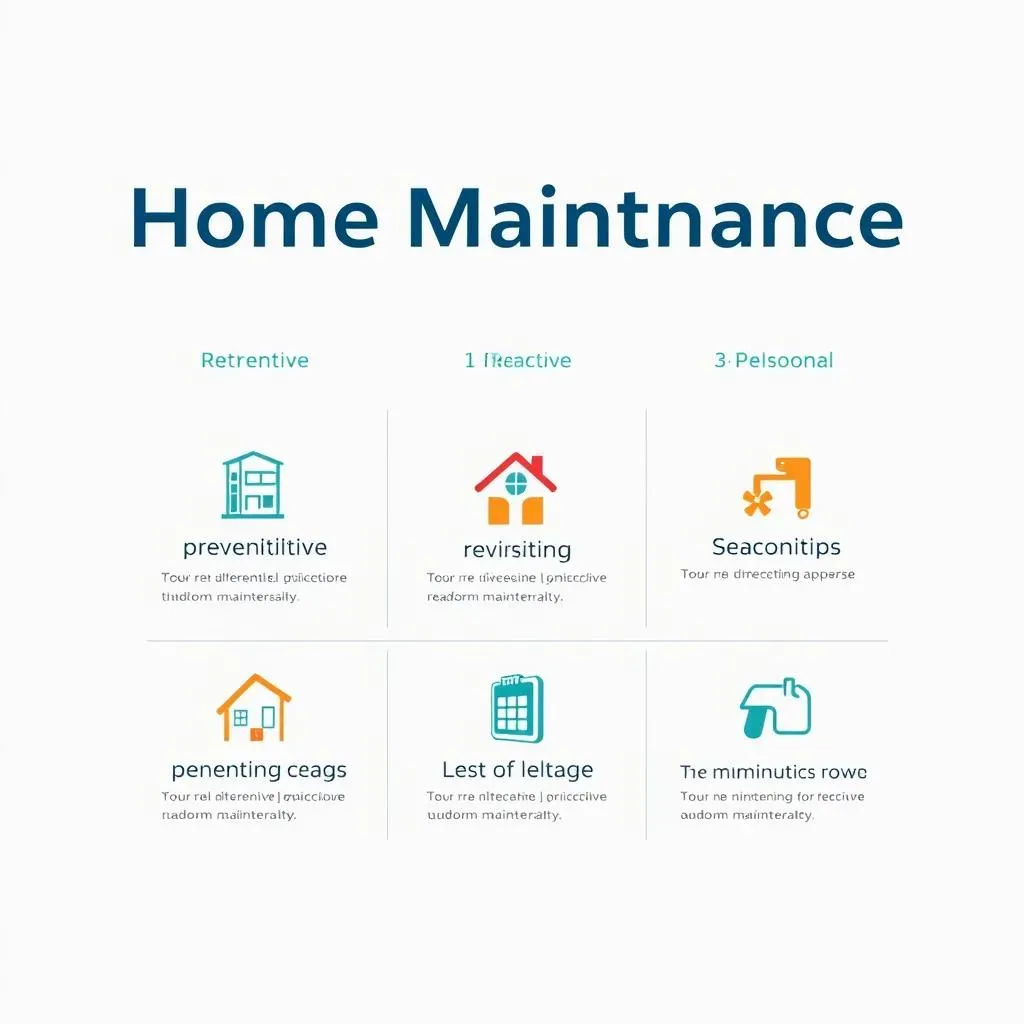Table of Contents
Owning a home is a huge accomplishment, a symbol of stability and a place to build memories. But with the pride of ownership comes responsibility, and a crucial part of that is understanding the various types of home maintenance. This isn't just about fixing things when they break; it's about proactive care that protects your investment and ensures your family's safety and comfort. This comprehensive guide will equip you with the knowledge to confidently navigate the world of home maintenance. We'll explore the essential types of home maintenance, covering everything from preventative measures that stop problems before they start to the reactive fixes needed when the unexpected happens. You'll learn to identify common issues, understand the importance of seasonal adjustments, and develop a practical strategy tailored to your specific needs. Whether you're a seasoned homeowner or just beginning your journey, mastering these types of home maintenance will save you money, reduce stress, and help you enjoy your home for years to come. Get ready to transform your approach to home care and become the ultimate home maintenance master!
Essential Types of Home Maintenance: A Quick Overview
Essential Types of Home Maintenance: A Quick Overview
Understanding the Big Picture of Home Maintenance
So, you're diving into the world of home maintenance? Fantastic! It can seem overwhelming at first, like facing a giant, complicated puzzle. But don't worry, it's not as scary as it looks. Think of it as a team sport – you're the captain, and your home is your team. To keep your team in top condition, you need a few key players: preventative maintenance, which is like regular training for your team; reactive maintenance, the emergency substitutions when something goes wrong; and seasonal maintenance, adjusting your team's strategy based on the weather. We'll break down each of these crucial areas, making home maintenance clear, manageable, and even – dare I say it – fun!
Type of Maintenance | Description | Example |
|---|---|---|
Preventative | Regular checks and cleaning to prevent problems. | Changing air filters, cleaning gutters. |
Reactive | Fixing problems that have already occurred. | Repairing a leaky faucet, replacing a broken window. |
Seasonal | Tasks specific to the time of year. | Winterizing pipes, mowing the lawn in summer. |
Different Types of Home Maintenance: A Closer Look
Let's get more specific. Preventative maintenance is all about avoiding costly repairs down the line. It's the small, regular tasks that keep your home running smoothly. Think of it like regular check-ups at the doctor – better to catch small issues early than wait for a major crisis. Reactive maintenance, on the other hand, is for when things go wrong. A burst pipe, a faulty appliance – these are emergencies that need immediate attention. Finally, seasonal maintenance is about adapting to the changing weather. Preparing for winter's freezing temperatures or summer's scorching heat is crucial for preventing damage and keeping your home comfortable.
- Regularly inspect appliances for wear and tear.
- Clean gutters and downspouts to prevent water damage.
- Schedule annual HVAC maintenance checks.
- Check smoke and carbon monoxide detectors monthly.
Preventative Home Maintenance: Avoiding Costly Repairs
Preventative Home Maintenance: Avoiding Costly Repairs
The Power of Prevention: Small Steps, Big Savings
Think of preventative home maintenance as insurance for your house. It's investing a little time and money now to avoid massive expenses later. A stitch in time saves nine, as they say! Regularly checking and cleaning key systems prevents small problems from snowballing into costly disasters. Imagine a tiny leak in your roof – left unchecked, it could lead to mold, structural damage, and a hefty repair bill. But catching it early? A simple sealant might be all it takes. This proactive approach is the cornerstone of smart homeownership. It's about building a foundation of care that protects your investment and your peace of mind. This isn't about being obsessive; it's about being sensible and strategic.
- Regularly inspect your roof for missing or damaged shingles.
- Clean your gutters and downspouts to prevent clogs and water damage.
- Check for cracks in your foundation and address them promptly.
- Inspect and clean your dryer vent to prevent fire hazards.
Practical Preventative Measures: A Checklist for Success
Let's get practical. Preventative maintenance isn't about complex tasks; it's about consistent, simple actions. Think of it like brushing your teeth – a small effort every day that makes a huge difference over time. Start with a basic checklist. Regularly inspect your appliances: check for leaks, strange noises, or unusual smells. Clean your gutters and downspouts at least twice a year, especially before and after heavy rain or snow. Test your smoke and carbon monoxide detectors monthly – this is a non-negotiable for safety. These small actions, performed regularly, will dramatically reduce your risk of costly repairs. Remember, an ounce of prevention is worth a pound of cure. And your wallet will thank you for it!
Task | Frequency | Why it's important |
|---|---|---|
Check smoke detectors | Monthly | Ensures early warning in case of fire |
Clean gutters | Twice yearly | Prevents water damage to roof and foundation |
Inspect appliances | Quarterly | Catches small problems before they become big ones |
Reactive Home Maintenance: Addressing Unexpected Issues
Reactive Home Maintenance: Addressing Unexpected Issues
When Things Go Wrong: Dealing with Reactive Home Maintenance
Okay, let's talk about the stuff that nobody wants to think about: the unexpected emergencies. A burst pipe at 3 AM? A power outage during a thunderstorm? These are the moments when reactive home maintenance becomes your best friend. It's all about damage control – minimizing the damage and getting things back to normal as quickly as possible. This isn't about preventing problems (that's preventative maintenance!), it's about fixing them efficiently and effectively. Think of it as having a well-stocked first-aid kit for your house – you don't want to need it, but you're awfully glad you have it when you do.
- Have a plumber's number on speed dial.
- Keep a basic toolkit handy for minor repairs.
- Know how to shut off your main water and electricity supplies.
- Consider a home warranty for major appliance repairs.
Strategies for Effective Reactive Home Maintenance
So, the unexpected has happened. Don't panic! The key to effective reactive maintenance is to stay calm, assess the situation, and take action. First, make sure everyone is safe. If there's a significant issue like a fire or a major leak, evacuate the house and call emergency services immediately. For less critical problems, try to identify the source of the issue. A leaky faucet? A clogged drain? Often, simple fixes can solve the problem. If you're unsure, don't hesitate to call a professional. Remember, attempting a complex repair yourself could worsen the situation and cost you even more money in the long run. Think of it like this: Sometimes, it's better to call in the cavalry.
Problem | Solution | When to call a professional |
|---|---|---|
Leaky faucet | Tighten the packing nut or replace the cartridge. | If the leak persists or you're uncomfortable working with plumbing. |
Clogged drain | Use a plunger or drain cleaner. | If the clog persists or you suspect a more serious plumbing issue. |
Power outage | Check circuit breakers and fuses. | If the problem persists or you suspect a wiring issue. |
Seasonal Types of Home Maintenance: Tailoring Your Approach
Seasonal Types of Home Maintenance: Tailoring Your Approach
Seasonal Types of Home Maintenance: Tailoring Your Approach
Now, let's talk about seasonal maintenance – the art of adapting your home care routine to the rhythm of the year. Think of it as giving your house a seasonal wardrobe change. Just as you wouldn't wear a winter coat in July, your home needs different care depending on the time of year. In winter, you're focused on protecting against freezing temperatures – insulating pipes, clearing snow from the roof. Spring brings a flurry of cleaning and yard work – prepping the garden, cleaning windows. Summer is about dealing with heat and humidity – cleaning air conditioning units, checking for leaks. And fall is all about preparing for the winter ahead – cleaning gutters, storing outdoor furniture. This seasonal approach is key to preventing damage and keeping your home functioning smoothly throughout the year. It’s about being proactive and anticipating the challenges each season brings.
Season | Key Tasks | Why it Matters |
|---|---|---|
Spring | Clean gutters, inspect roof, fertilize lawn | Prevents water damage, ensures healthy lawn |
Summer | Clean AC unit, check for leaks, inspect deck | Maintains efficient cooling, prevents water damage |
Fall | Clean gutters, winterize pipes, store outdoor furniture | Prevents clogs, protects pipes from freezing |
Winter | Check insulation, clear snow from roof, inspect heating system | Maintains warmth, prevents damage from snow and ice |
Let's dive a little deeper into the specifics of seasonal home maintenance. Spring cleaning isn't just about tidying up; it's about inspecting your home for any damage sustained over the winter. Check for cracks in the foundation, inspect the roof for missing shingles, and give your gutters a thorough cleaning to prevent water damage. Summer is all about maintaining efficient cooling. Clean your air conditioning unit's coils and filters, check for leaks in the plumbing, and ensure your deck is structurally sound. In the fall, preparing for winter is crucial. Clean your gutters again (yes, really!), winterize your pipes to prevent freezing, and store outdoor furniture to protect it from the elements. Finally, winter is all about ensuring your home stays warm and safe. Check your insulation, clear snow from your roof to prevent structural damage, and make sure your heating system is functioning properly. This isn't just about comfort, it's about safety. A well-maintained home is a safe home.
- Create a seasonal checklist tailored to your specific climate and home.
- Consider hiring professionals for tasks you're not comfortable handling.
- Regularly inspect your home for signs of wear and tear.
- Don't forget about preventative maintenance – it's crucial year-round!